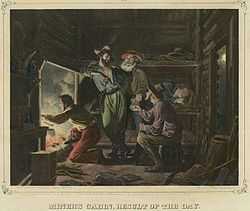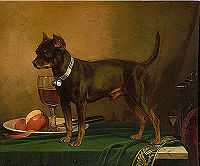Frederick August Wenderoth
| Frederick August Wenderoth | |
|---|---|
|
Miners in the Sierra | |
| Born |
1819 Cassel, Germany |
| Died |
1884 (aged 64–65) Philadelphia, US |
| Education |
|
Frederick August Wenderoth or F. A. Wenderoth (1819 – 1884) was a German-born American painter and photographer. Born and educated in Cassel, where he first learned to paint from his father, he established a lifelong friendship with Charles Christian Nahl at school. During a period of political upheaval he left Germany for Paris where his was joined by Nahl and his half-brother Hugo Wilhelm Arthur Nahl.They then moved to the US, living first in New York, before traveling by sea to California to join the Gold Rush.
Unsuccessful as miners, Wenderoth and Nahl opened art studios, first in Sacramento and later in San Francisco, collaborating as painters, engravers and photographers. After a trip to South Seas and Australia, Wenderoth married and moved to Philadelphia, where he established a photography studio. In the late 1850s he worked for a period in South Carolina, going into partnership with Jesse Bolles. There, and later when he returned to Philadelphia, he innovated a number of photographic techniques, such as the ivory-type and photozincography. Wenderoth died in 1884 of tuberculosis.
Early years
Frederick August Wenderoth was born in 1819, in Cassel, Germany, to Carl Wenderoth, a painter; his mother was a lady-in-waiting at the Hesse-Kassel court. As a child his father gave him painting lessons,[1] before he went on to study at the Kunstakademie Cassel with Frederick Mueller.[2] At the academy he met Carl Christian Nahl, who became his lifelong friend.[1] At 18, Wenderoth gave art lessons to the young women at court. In 1845, during a period of political upheaval, he left Germany for Paris, and from there traveled to Algeria. Upon his return to Paris, he was joined by Nahl and his family, with the two friends exploring the Louvre and other art museums,[1] and Wenderoth took the opportunity to study with Léon Cogniet.[2] In 1849, with the Nahl family, Wenderoth left Paris for the United States, settling in Brooklyn,[3] where, between 1849 and 1850, he sold nine paintings at the American Art-Union exhibitions.[1]
California gold rush
In 1851, Wenderoth and the Nahl family joined the California Gold Rush.[3] The sea-route to the west coast goldfields was considered far easier than the arduous 2,000 mile-long overland route, with its dangers of illness, thirst, and Indian attacks. Those who chose to travel from the eastern United States west by sea were dubbed Argonauts.[4] Wenderoth and the Nahls left New York in March, traveled by boat to Havana, Cuba, then on to Chagres, Panama. They crossed the Isthmus of Panama by foot, and from there took a boat to San Francisco, arriving there in May.[3]

Most argonauts stayed in San Francisco to make plans, gather supplies, and recuperate from the voyage. Wenderoth and Nahls, however left the city the next day,[4] inland to the gold fields on the Yuba River in the Sierras. Arriving in Rough and Ready, the two friends, with Nahls' half-brother Arthur, staked a claim[5] along the banks of Deer Creek, which they quickly found had been salted.[3] Instead of mining, they sketched the miners in the foothills,[1] and Wenderoth may have taken daguerreotype photographs of miners at this time.[2] Their experience in the mining camps is captured on two stone lithographs, signed by both artists. One shows the interior of a miners cabin at night, the second shows a miner prospecting. They are significant because they inspired two later paintings: Nahls' 1856 Saturday Night in the Mines, (painted with his brother), and A. D. O. Browere's 1853 The Lone Prospector.[5]
By the end of 1851 they had moved to and set up a studio in Sacramento,[1] on Fourth Street, where among other items, they sold paintings depicting the gold rush.[3] The Placer Times wrote of them on January 1852: "An opportunity if now offered the citizens of Sacramento to gratify their taste for this exalted branch of the fine arts ... of early times in California".[5] The piece mentions that the two took photographs, however, that has not been definitely established. They most likely did paint miniature portraits, perhaps based on daguerreotypes.[5]
Probably at this time they painted the well-known Miners in the Sierra.[3] The large-scale work (54 1/4 x 66 7/8 in. (137.7 x 169.8 cm)[6] shows miners working in collaboration against a background landscape.[7] The mining genre painting shows four miners working together in a high mountain canyon, using a sluice box to extract gold from the river bed. Anthony Kirk, of the California Historical Society, writes that the painting is "powerful and authentic, wonderfully suggestive of the colossal labor necessary to wrest riches from the earth."[4] Additionally, Wenderoth and Nahl made engravings for the Placer Times and the The Sacramento Union.[3]
Photographer and miniaturist

When the Great Fire of Sacramento destroyed the city, their work was burned, and they returned to San Francisco. They established a studio there and quickly gained a reputation. In 1853, Alonzo Delano commissioned illustrations for his Pen Knife Sketches from Wenderoth and Nahl, and a year later they were advertising themselves as daguerreotypists.[3] Additionally Wenderoth worked on miniature portraits at this time, most likely from daguerreotypes images. These were painted on "wafer-thin ivory" in watercolors, such as his 1854 Portrait of a Man.[5]
Between 1852 and 1853, Wenderoth traveled to the South Seas and on to Australia.[1] On his return, in 1856 he married Nahl's half-sister, Laura. The newly married couple returned to Philadelphia where they meant to settle. However, shortly afterward Laura died during childbirth, along with her infant.[1]
In 1857 Wenderoth was living in Charleston, South Carolina, where he went into business with Jesse H. Bolles for about a year. During this period he seems to have perfected color stereoscopic ambrotypes and ivory types. Ivory types consist of placing an photograph and a painting "of the same subject over each other into a kind of sandwich that is then sealed together with beeswax."[8]
In 1858 he returned to Philadelphia. There Wenderoth worked for Harper's Weekly, producing illustrations and photographs,[2] and established a business on Chestnut Street, with partner William Curtis Taylor. They were joined by John Henry Brown, a well-known miniaturist. The firm specialized in coloring photographs, which, though growing in popularity, were considered inferior because of the lack of color. Wenderoth and his colleagues created photographic colorization techniques called "Ivorytypes", "Opalotypes" and the "New Crayon" in which color washes made a photographic portrait appear more like a painting, and thus more marketable.[9]
In 1884 Wenderoth died in Philadelphia of tuberculosis.[2]
Gallery
-

Rider on white horse, 1849, oil on canvas, 29.13" by 23.62". The painting had been destroyed and was restored by 2008 when it was sold at a Fine Arts auction.[1]
-

A Winner, 1849 -

Little Terrier, 1875
- ^ Reiterin auf nach links aufsteigendem Schimmel. Blouin Art Sales Index. Retrieved 22 January 2014.
References
- ↑ 1.0 1.1 1.2 1.3 1.4 1.5 1.6 1.7 Driesbach, Janice (1998). Art of the Gold Rush. University of California Press. p. 129. ISBN 978-0520214316.
- ↑ 2.0 2.1 2.2 2.3 2.4 "F. A. Wenderoth". Historic Camera. Retrieved 16 January 2014.
- ↑ 3.0 3.1 3.2 3.3 3.4 3.5 3.6 3.7 Palmquist, Peter E.; Kailbourn, Thomas R. (2000). Pioneer Photographers of the Far West. Stanford University Press. pp. 415, 590.
- ↑ 4.0 4.1 4.2 Kirk, Anthony. "Seeing the Elephant". California History , Vol. 77, No. 4, (Winter, 1998/1999) , pp. 174-184
- ↑ 5.0 5.1 5.2 5.3 5.4 Driesbach, Janice (1998). Art of the Gold Rush. University of California Press. pp. 47–48. ISBN 978-0520214316.
- ↑ "Miners in the Sierras". Smithsonian American Art Museum. Retrieved 17 January 2014.
- ↑ "California, Art of the Gold Rush". Oakland Museum of California. Retrieved 17 January 2014.
- ↑ Teal, Harvey S. Partners with the Sun: South Carolina Photographers, 1840-1940. Univ of South Carolina Press, 2001. ISBN 9781570033841, p. 60
- ↑ Frank, Robin. "Three Small Portraits Punctuate a Bigger Story". Yale University Art Gallery Bulletin , (2001) , pp. 32-43
External links
| Wikimedia Commons has media related to Frederick August Wenderoth. |
- Frederick August Wenderoth askart.com
- Frederick August Wenderoth blouinartinfo.com
- Frederick August Wenderoth web.artprice.com
